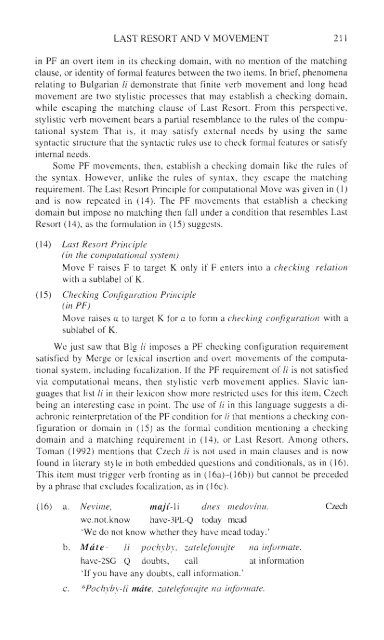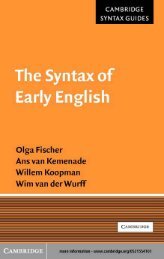Comparative Syntax of the Balkan Languages (Oxford ... - Cryptm.org
Comparative Syntax of the Balkan Languages (Oxford ... - Cryptm.org
Comparative Syntax of the Balkan Languages (Oxford ... - Cryptm.org
- No tags were found...
You also want an ePaper? Increase the reach of your titles
YUMPU automatically turns print PDFs into web optimized ePapers that Google loves.
LAST RESORT AND V MOVEMENT 211in PF an overt item in its checking domain, with no mention <strong>of</strong> <strong>the</strong> matchingclause, or identity <strong>of</strong> formal features between <strong>the</strong> two items. In brief, phenomenarelating to Bulgarian li demonstrate that finite verb movement and long headmovement are two stylistic processes that may establish a checking domain,while escaping <strong>the</strong> matching clause <strong>of</strong> Last Resort. From this perspective,stylistic verb movement bears a partial resemblance to <strong>the</strong> rules <strong>of</strong> <strong>the</strong> computationalsystem That is, it may satisfy external needs by using <strong>the</strong> samesyntactic structure that <strong>the</strong> syntactic rules use to check formal features or satisfyinternal needs.Some PF movements, <strong>the</strong>n, establish a checking domain like <strong>the</strong> rules <strong>of</strong><strong>the</strong> syntax. However, unlike <strong>the</strong> rules <strong>of</strong> syntax, <strong>the</strong>y escape <strong>the</strong> matchingrequirement. The Last Resort Principle for computational Move was given in (1)and is now repeated in (14). The PF movements that establish a checkingdomain but impose no matching <strong>the</strong>n fall under a condition that resembles LastResort (14), as <strong>the</strong> formulation in (15) suggests.(14)(15)Last Resort Principle(in <strong>the</strong> computational system)Move F raises F to target K only if F enters intowith a sublabel <strong>of</strong> K.Checking Configuration Principle(in PF)Move raises a to target K for a to form a checkingsublabel <strong>of</strong> K.(16) a. Nevime, maji-li dnes medovinu. Czechwe. not. know have-3PL-Q today mead'We do not know whe<strong>the</strong>r <strong>the</strong>y have mead today.'b. Mate -have-2SGliQpochyby ,doubts,zatelefonujtecallIf you have any doubts, call information.'c. *Pochyby-linaatmate, zatelefonujte na informate.a checking relationconfiguration with aWe just saw that Blg li imposes a PF checking configuration requirementsatisfied by Merge or lexical insertion and overt movements <strong>of</strong> <strong>the</strong> computationalsystem, including localization. If <strong>the</strong> PF requirement <strong>of</strong> // is not satisfiedvia computational means, <strong>the</strong>n stylistic verb movement applies. Slavic languagesthat list li in <strong>the</strong>ir lexicon show more restricted uses for this item, Czechbeing an interesting case in point. The use <strong>of</strong> //' in this language suggests a diachronicreinterpretation <strong>of</strong> <strong>the</strong> PF condition for li that mentions a checking configurationor domain in (15) as <strong>the</strong> formal condition mentioning a checkingdomain and a matching requirement in (14), or Last Resort. Among o<strong>the</strong>rs,Toman (1992) mentions that Czech li is not used in main clauses and is nowfound in literary style in both embedded questions and conditionals, as in (16).This item must trigger verb fronting as in (16a)-(16b)) but cannot be precededby a phrase that excludes localization, as in (16e).informate.information
















